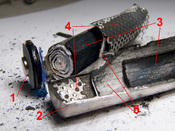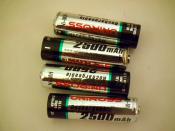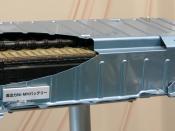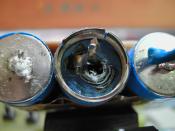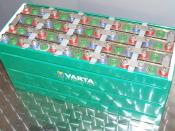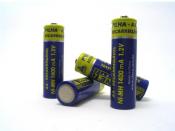Electric vehicles can benefit us in many ways. Comparing with the internal combustion engine, EVs don't cause pollution when operating. They can run in a long period of time. Economically, because these vehicles using battery, they reduce the oil import and the imbalance trading in the US and also the users save a lot of money. The cells used for these vehicles are called Nickel metal hydride battery which are very high power, long life, quick charge and easy to maintain.
CELL REACTION The NiMH battery stores hydrogen as a reaction product in the solid phase. The anode electrode contain hydrogen material that can allow electrochemical storage and release of hydrogen during charge and discharge. The cathode electrode is reversible between Ni(OH)2 and nickel oxyhydroxide (NiOOH). At both electrode, oxidation-reduction reactions take place in an alkaline medium consisting of 30% by weight KOH in water. When charging, Ni(OH)2 at the positive electrode becomes oxidized and the metal hydride becomes reduced.
In fact, the hydrogen which was separated from water come to react with the metal in the negative electrode to form MH. On the other hand, the hydroxyl ion ( from water) reacts with Ni(OH)2 at the positive electrode to form NiOOH. Ni now change from +2 to +3.
M + H2O + e = MH + OH Ni(OH)2 +OH = NiOOH + H2O + e From equation (1) and (2) there is no net change in electrolyte quantity or concentration over the charge and discharge cycle. We can see that it is different from other alkaline electrode such as NiCd which water is produced at both electrode during charge and used up during discharge. In the NiMH battery, the constant average concentration can reduce the corrosion and swelling.
MATERIAL REQUIRED Because the NiMH battery need to store a large amount of hydrogen to produce high energy, it is desirable to have high electrode capacity. Importantly, in the desire of MH, the range of metal to hydrogen bond strengths must be from 6 to 12 kcal /mol. If the bond strength is too weak, hydrogen will not react with the alloys and will be evaporate as a gas. If the bond strength is too large, the MH electrode becomes oxidized and does not store hydrogen reversibly. Furthermore, the power output of the battery depend on the electrochemical kinetics and transport processes which are involved in the use of the hydride material. During discharge, hydrogen in the bulk metal go through the surface by diffusion to react with hydroxyl ions at the metal electrolyte interface, the surface porosity, the oxide thickness, electrical conductivity, topology and surface areas affect the rate at which energy can be stored in and removed from the NiMH battery. In a sealed system, a battery When overcharge, oxygen gas is generated at the Ni(OH)2 positive electrode and must recombine with hydrogen at the MH electrode to form water., a battery When overdischarge, which occurs when a low capacity cell in a series connected string is subjected to reverse polarity, hydrogen is generated at the Ni(OH)2 electrode and must be recombine at the surface of the MH electrode to form water. Because the reaction involved in gas formation, the condition required good electrode area, thin electrolyte film and for hydrogen absorption process, the catalytic activity at the MH electrode surface to promote rapid dissociation of hydrogen.
An Ovonic NiMH battery with a volume of 31.6 kwh can run a car in 480 km. The disposal of this battery is safe in landfill. It can be recycled into metallurgical additives for cast iron, stainless steel or new Ovonic NiMH battery electrode.
The presentation of Nickel metal hydride battery is the improvement for transportation. This battery also play an important role in the environment and society.
